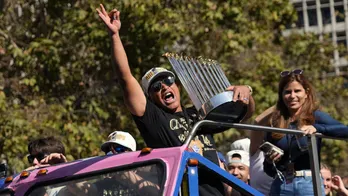'You don't need to stop loving cricket to start loving football': LaLiga India's MD Jose Antonio Cachaza
La Liga is one of the rapidly growing football leagues in terms of fanbase in India, and one of the pioneers for its rapid expansion is Jose Antonio Cachaza, the Managing Director for the league in the country. Cachaza has been instrumental in expanding La Liga's reach in India through partnerships with local organizations and initiatives such as the La Liga Football Schools program, which aims to promote grassroots football development across the country. The Hindustan Times sat with Cachaza to understand the insights about La Liga’s operations in this country, as it took another step towards increasing engagement with the Indian fanbase on Monday; the league, in partnership with the Embassy of Spain in India and the Instituto Cervantes, launched a Spanish-Hindi football dictionary at the Residence of the Embassy of Spain in New Delhi.

Cachaza arrived in India in 2017; interestingly enough, Cachaza had revealed in an interview last year that he didn’t know a thing about India and its economics when he first landed in the country.
“I will tell you a little story. I had been trying to understand India and its economics since the very beginning. A few months after I came here, I told a friend, ‘I’ll never fully understand India’. And this person says, ‘it’s okay if you’re struggling to understand India, because we don’t understand it either!’” Cachaza tells us.
Then, he shares a piece of advice he received from a Spanish friend working in India which helped him adjust to the dynamics in this country.
“Basically, you must understand how to deal with situation and persons. Every country has a business culture that is different. When I came to India, a Spanish friend who conducts business in Tamil Nadu gave me an advice; ‘In India, you have to be patient’. And it was a great advice. What he did not tell me, though, is that Indians are incredibly impatient! That is a contradiction we have to balance every day here. I try to understand how to deal with the situation, how to pitch the product to who-is-who in the market. Those are the basics in any industry in this country. In football, our clients are fans, potential sponsors, title sponsors, broadcasters… it is quite complex! And I’m still learning,” says Cachaza.
But even as unfamiliarity with the Indian market was a concern for Cachaza, he did know one thing; Cricket is the most popular sport in the country, just as football is in Spain. Was it hard adjusting to that reality?
“Not really. Honestly, I never felt the pressure because I was quite aware about where football is, and where La Liga stands in India. We knew we are not the no.1 in a sport which isn’t no.1 (referring to Premier League’s fanbase in India). We needed to climb in that way. Also, I’ve to say that my bosses in Madrid, starting by Javier Tebas, understood this. We are in India with a long-term approach of building our brand and business, and our fan-base, not in that order. I always had a full support in terms of that. Of course, we have pressure of selling the product, but it was never a key pointer. The objective was, and still is, to keep building the brand,” Cachaza explains.
In 2019, La Liga did cash in on the popularity of cricket in India as they brought on board Rohit Sharma as the ambassador for the league in the country. The star Indian batter is a big Real Madrid fan and was, at the time, an integral member of the Indian team. Rohit eventually went to become the captain of men’s national team across all formats in 2021. The decision, however, met with certain criticism from fans on social media but Cachaza explains it was a carefully thought-out call.
“Basically, there were ups and downs. The relationship with Rohit came at a time when we thought it would help us to have a brand ambassador in India. We thought about Bollywood actors as well, all fantastic; but then, we realised that working with cricketer would make more sense than a Bollywood actor. Of course, we had complaints from fans on social media about why we had a cricketer. At the end, that’s where the following is. Rohit has the same number of followers as Ranveer Singh, the brand ambassador of the Premier League,” says the La Liga MD.
“But cricket fans are sports fans. With Rohit, you’re telling them, ‘listen, you don’t need to stop loving cricket to start loving football. If your hero loves football and La Liga, so can you’. That was the underlying message. With Bollywood, a big chunk of their following won’t be sports fans. With cricketers, most will be sports fans.”
And La Liga did grow. Even with the departure of Cristiano Ronaldo and Lionel Messi – two of the most bankable stars in sporting world – La Liga continues to maintain a sustainable fanbase in the country. What helps more, according to Cachaza, is the revival of FC Barcelona this year.
Barcelona are on course to winning the La Liga title this year – their first since 2019.
“It’s important. Because we need fans to develop loyalty. I perceive, in Asia, and particularly in India, there’s a clear revolution that they start following stars and it leads them to following clubs. It’s happened majorly from David Beckham’s era. You look at Manchester United; they have been underperforming for the last 10 years, but they’re still in the top-3 clubs. That tells you that the loyalty towards the club stays there.
“Barca and Madrid will always be there. They will be up and down, but they will be there. Our challenge is to make fans more aware about Atletico Madrid, Sevilla, Villarreal, Real Betis, Bilbao… that’s our real challenge. To make fans more aware about the second-tier clubs,” says Cachaza.
La Liga at grassroots
Last year, Kajol D’Souza, one of the students of La Liga Football Schools, went on to represent India at the FIFA U17 Women’s World Cup. Cachaza says she will soon be travelling to Europe. “Kajol will be going to Europe. She’s going to get a La Liga scholarship for training in Spain,” he reveals.
The work is far from done, however, and the La Liga MD stresses on the need for better competitions – particularly at the youth level.
“Honestly, when you develop football school projects, you have hopes but you don’t have a clear path traced towards high-performance academies. It’s good that you have boys and girls moving over to ISL academies or Tata academies. Some of our kids have moved to ISL academies. We are the first step; in men’s football, the level of youth competition is not big enough in India. In women’s football, the situation is even worse. But that’s in Spain as well. That’s a challenge we all need to give more attention to,” says Cachaza.
Disclaimer: The copyright of this article belongs to the original author. Reposting this article is solely for the purpose of information dissemination and does not constitute any investment advice. If there is any infringement, please contact us immediately. We will make corrections or deletions as necessary. Thank you.







